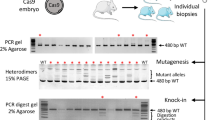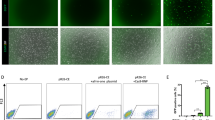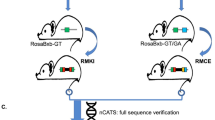Abstract
Single-stranded oligodeoxynucleotide (ssODN) gene targeting may facilitate animal model creation and gene repair therapy. Lipofection of ssODN can introduce point mutations into target genes. However, typical efficiencies in mouse embryonic stem cells (ESC) are <10−4, leaving corrections too rare to effectively identify. We developed ESC lines with an integrated mutant neomycin resistance gene (Tyr22Ter). After targeting with ssODN, repaired cells survive selection in G418. Correction efficiencies varied with different lipofection procedures, clonal lines, and ssODN designs, ranging from 1 to 100 corrections per million cells plated. Uptake studies using cell sorting of Cy5-labelled ssODN showed 40% of the corrections concentrated in the best transfected 22% of cells. Four different basepair mismatches were tested and results show that the base-specificity of the mismatch is critical. Dual mismatch ssODN also showed mismatch preferences. These ESC lines may facilitate development of improved ssODN targeting technologies for either animal production or ex vivo gene therapy.
This is a preview of subscription content, access via your institution
Access options
Subscribe to this journal
Receive 12 print issues and online access
$259.00 per year
only $21.58 per issue
Buy this article
- Purchase on Springer Link
- Instant access to full article PDF
Prices may be subject to local taxes which are calculated during checkout






Similar content being viewed by others
References
Ramirez-Solis R, Liu P, Bradley A . Chromosome engineering in mice. Nature 1995; 378: 720–724.
Richardson PD, Augustin LB, Kren BT, Steer CJ . Gene repair and transposon-mediated gene therapy. Stem Cells 2002; 20: 105–118.
Moerschell RP, Tsunasawa S, Sherman F . Transformation of yeast with synthetic oligonucleotides. Proc Natl Acad Sci USA 1988; 85: 524–528.
Igoucheva O, Alexeev V, Yoon K . Targeted gene correction by small single-stranded oligonucleotides in mammalian cells. Gene Ther 2001; 8: 391–399.
Havre PA, Gunther EJ, Gasparro FP, Glazer PM . Targeted mutagenesis of DNA using triple helix-forming oligonucleotides linked to psoralen. Proc Natl Acad Sci USA 1993; 90: 7879–7883.
Yoon K, Cole-Strauss A, Kmiec EB . Targeted gene correction of episomal DNA in mammalian cells mediated by a chimeric RNA. DNA oligonucleotide. Proc Natl Acad Sci USA 1996; 93: 2071–2076.
Brachman EE, Kmiec EB . Targeted nucleotide repair of cyc1 mutations in Saccharomyces cerevisiae directed by modified single-stranded DNA oligonucleotides. Genetics 2003; 163: 527–538.
Olsen PA, Randol M, Krauss S . Implications of cell cycle progression on functional sequence correction by short single-stranded DNA oligonucleotides. Gene Therapy 2005; 12: 546–551.
Pierce EA, Liu Q, Igoucheva O, Omarrudin R, Ma H, Diamond SL et al. Oligonucleotide-directed single-base DNA alterations in mouse embryonic stem cells. Gene Therapy 2003; 10: 24–33.
Dekker M, Brouwers C, teRiele H . Targeted gene modification in mismatch-repair-deficient embryonic stem cells by single-stranded DNA oligonucleotides. Nucleic Acids Res 2003; 31: e27.
Nickerson HD, Colledge WH . A comparison of gene repair strategies in cell culture using a lacZ reporter system. Gene Therapy 2003; 10: 1584–1591.
Brachman EE, Kmiec EB . DNA replication and transcription direct a DNA strand bias in the process of targeted gene repair in mammalian cells. J Cell Sci 2004; 117: 3867–3874.
Parekh-Olmedo H, Ferrara L, Brachman E, Kmiec EB . Gene therapy progress and prospects: targeted gene repair. Gene Ther 2005; 12: 639–646.
Ma H, Liu Q, Diamond SL, Pierce EA . Mouse embryonic stem cells efficiently lipofected with nuclear localization peptide result in a high yield of chimeric mice and retain germline transmission potency. Methods 2004; 33: 113–120.
Gamper HB, Parekh H, Rice MC, Bruner M, Youkey H, Kmiec EB . The DNA strand of chimeric RNA/DNA oligonucleotides can direct gene repair/conversion activity in mammalian and plant cell-free extracts. Nucleic Acids Res 2000; 28: 4332–4339.
Li XT, Costantino N, Lu LY, Liu DP, Watt RM, Cheah KS et al. Identification of factors influencing strand bias in oligonucleotide-mediated recombination in Escherichia coli. Nucleic Acids Res 2003; 31: 6674–6687.
Igoucheva O, Alexeev V, Pryce M, Yoon K . Transcription affects formation and processing of intermediates in oligonucleotide-mediated gene alteration. Nucleic Acids Res 2003; 31: 2659–2670.
Wu XS, Xin L, Yin WX, Shang XY, Lu L, Watt RM et al. Increased efficiency of oligonucleotide-mediated gene repair through slowing replication fork progression. Proc Natl Acad Sci USA 2005; 102: 2508–2513.
Nagy A . Manipulating the Mouse Embryo. In: Gertsenstein MVKBR (ed). A Laboratory Manual. Cold Stone Harbor Laboratory Press, 2003, pp 128–252.
Almofti MR, Harashima H, Shinohara Y, Almofti A, Li W, Kiwada H . Lipoplex size determines lipofection efficiency with or without serum. Mol Membr Biol 2003; 20: 35–43.
Tseng WC, Haselton FR, Giorgio TD . Transfection by cationic liposomes using simultaneous single cell measurements of plasmid delivery and transgene expression. J Biol Chem 1997; 272: 25641–25647.
Hu Y, Parekh-Olmedo H, Drury M, Skogen M, Kmiec EB . Reaction parameters of targeted gene repair in Mammalian cells. Mol Biotechnol 2005; 29: 197–210.
Olsen PA, Randol M, Luna L, Brown T, Krauss S . Genomic sequence correction by single-stranded DNA oligonucleotides: role of DNA synthesis and chemical modifications of the oligonucleotide ends. J Gene Med 2005; 7: 1534–1544.
Kenner O, Lutomska A, Speit G, Vogel W, Kaufmann D . Concurrent targeted exchange of three bases in mammalian hprt by oligonucleotides. Biochem Biophys Res Commun 2004; 321: 1017–1023.
van der Steege G, Schuilenga-Hut PH, Buys CH, Scheffer H, Pas HH, Jonkman MF . Persistent failures in gene repair. Nat Biotechnol 2001; 19: 305–306.
Yamamoto T, Moerschell RP, Wakem LP, Komar-Panicucci S, Sherman F . Strand-specificity in the transformation of yeast with synthetic oligonucleotides. Genetics 1992; 131: 811–819.
Igoucheva O, Alexeev V, Yoon K . Oligonucleotide-directed mutagenesis and targeted gene correction: a mechanistic point of view. Curr Mol Med 2004; 4: 445–463.
Rubin E, Levy AA . A mathematical model and a computerized simulation of PCR using complex templates. Nucleic Acids Res 1996; 24: 3538–3545.
Banks GA, Roselli RJ, Chen R, Giorgio TD . A model for the analysis of nonviral gene therapy. Gene Ther 2003; 10: 1766–1775.
Rice MC, Bruner M, Czymmek K, Kmiec EB . In vitro and in vivo nucleotide exchange directed by chimeric RNA/DNA oligonucleotides in Saccharomyces cerevisae. Mol Microbiol 2001; 40: 857–868.
Acknowledgements
The assistance of Richard Schretzenmair and Bill Murphy of the University of Pennsylvania Flow Cytometry and Cell Sorting Facility is gratefully acknowledged. We thank Gui-shuang Ying and Chengcheng Liu of the Center of Preventive Ophthalmology and Biostatistics for assistance with statistical analysis. This work was funded by Grants from NIH HL66565 (SLD), NIH PO1-CA72765, the Rosanne Silbermann Foundation, the Mackall Foundation Trust and the FM Kirby Foundation (EAP).
Author information
Authors and Affiliations
Corresponding author
Rights and permissions
About this article
Cite this article
Murphy, B., Moayedpardazi, H., Gewirtz, A. et al. Delivery and mechanistic considerations for the production of knock-in mice by single-stranded oligonucleotide gene targeting. Gene Ther 14, 304–315 (2007). https://doi.org/10.1038/sj.gt.3302866
Received:
Revised:
Accepted:
Published:
Issue Date:
DOI: https://doi.org/10.1038/sj.gt.3302866
Keywords
This article is cited by
-
Progress and prospects: oligonucleotide-directed gene modification in mouse embryonic stem cells: a route to therapeutic application
Gene Therapy (2011)
-
Genetic correction of splice site mutation in purified and enriched myoblasts isolated from mdx5cv mice
BMC Molecular Biology (2009)
-
Single-strand DNA-mediated targeted mutagenesis of genomic DNA in early mouse embryos is stimulated by Rad51/54 and by Ku70/86 inhibition
Gene Therapy (2008)
-
Site-specific gene modification by oligodeoxynucleotides in mouse bone marrow-derived mesenchymal stem cells
Gene Therapy (2008)
-
Progress and Prospects: targeted gene alteration (TGA)
Gene Therapy (2007)



